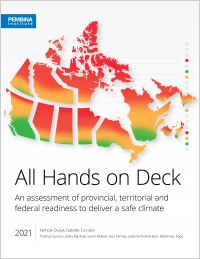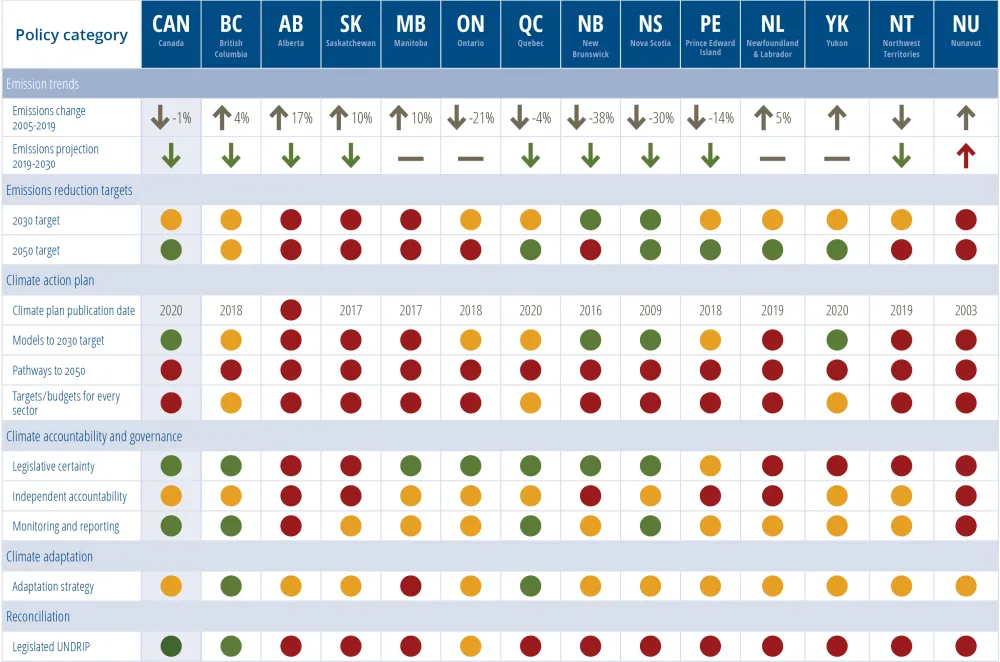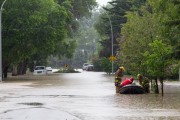With the damaging impacts of climate change more readily apparent around the world, and with national governments and international investors preparing to put economies on a low-carbon diet, we asked ourselves how ready Canada’s provinces and territories are to act on climate.
To answer that question, we teamed with Simon Fraser University’s School of Resource and Environmental Management to assess every province, territory and the federal government on 11 categories and 24 indicators that are foundational for climate action. These include climate plans and modelling, emissions targets, accountability legislation, carbon pricing, strong methane regulations, zero-emission vehicle mandates, building retrofit measures, legislation of the United Nations Declaration on the Rights of Indigenous Peoples, and many, many more.
Together we evaluated each government on each indicator, and then invited governments to review the accuracy and completeness of the data and summary for their region prior to publication. For every applicable criterion, each government was given a rating depending on extent of leadership.
What did we find?
 Our report, All Hands on Deck: An assessment of provincial, territorial and federal readiness to deliver a safe climate, found that although Canada’s provinces and territories hold much of the power over the country’s energy resources, the majority lack the policy infrastructure and measures necessary to achieve significant greenhouse gas emission reductions.
Our report, All Hands on Deck: An assessment of provincial, territorial and federal readiness to deliver a safe climate, found that although Canada’s provinces and territories hold much of the power over the country’s energy resources, the majority lack the policy infrastructure and measures necessary to achieve significant greenhouse gas emission reductions.
We found that although the federal government has set 2030 and 2050 emission reduction targets, 50% of national emissions (from Alberta, Saskatchewan and Manitoba) are not covered by a provincial or territorial 2030 target, and almost three-quarters (74%) of national emissions (from Alberta, Ontario, Saskatchewan and Manitoba) are not covered by a provincial or territorial 2050 target.
With respect to accountability for delivering on a nation-wide 2030 target, we found that 95% of emissions aren’t covered by provincial or territorial 2030 reduction targets or independently verified climate plans that will deliver the stated subnational 2030 target. We also found that with the exception of Manitoba, governments across the country have yet to adopt carbon budgets.
The two sectors driving emissions growth — offsetting decreases elsewhere — are oil and gas, and transportation. Since 2005, emissions from Canada’s oilsands increased 137%, and emissions from transportation increased 16%, with freight emissions increasing at three times the rate of passenger emissions.
However, none of the oil- and gas-producing provinces are preparing for the decline of oil and gas with inclusive, equitable transition plans and sufficient measures to deal with fossil fuel liabilities, and no jurisdictions are utilizing all of the policy tools at their disposal to dramatically lower transportation emissions. Because the oil and gas and transportation sectors threaten Canada’s ability to deliver on climate targets, bold, immediate action is needed to transform these sectors.
What can provinces, territories, and the federal government do?
Though climate success does not require a uniform approach for every province and territory, the evaluation did reveal six actions urgently needed across Canada.
To plan for climate success:
- Federal, provincial and territorial governments need to set higher emissions reduction targets and shrinking carbon budgets;
- To deliver on targets, provinces and territories need accountability legislation with climate modelling and independent verification;
- Provinces and territories need to prioritize reconciliation and equity.
To address sectoral emissions:
- Federal, provincial and territorial governments need to set sectoral emissions budgets and plan to respect them ﹘ focusing on the highest-emitting sectors first;
- Oil- and gas-producing provinces and territories need to create inclusive, equitable transition plans for the oil and gas sector based on net-zero pathways;
- Provinces and territories need to decarbonize passenger and freight transportation, and increase access to public transit and forms of active transportation.
To unlock a prosperous future for all, we need bold action on climate from governments across Canada. Success requires all hands on deck. We can no longer afford the delays that come from dismantling and redesigning policies — it’s time to scale up, not water down through weak implementation and offsetting policies elsewhere. Canada has an opportunity to be a global leader in decarbonization, and to position its economy and workforce for success in a low-carbon world. But all levels of government have a role to play in reducing emissions. This assessment of foundational climate policies and measures provides a roadmap for action.









